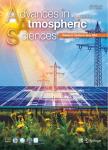Reducing Uncertainties in Climate Projections with Emergent Constraints:Concepts, Examples and Prospects
Reducing Uncertainties in Climate Projections with Emergent Constraints:Concepts, Examples and Prospects作者机构:CNRM Université de Toulouse Météo-France CNRS
出 版 物:《Advances in Atmospheric Sciences》 (大气科学进展(英文版))
年 卷 期:2020年第37卷第1期
页 面:1-15页
核心收录:
学科分类:07[理学] 070601[理学-气象学] 0706[理学-大气科学]
基 金:funding from the Agence Nationale de la Recherche (ANR) [grant HIGH-TUNE ANR-16-CE01-0010]
主 题:climate modeling emergent constraint climate change climate sensitivity
摘 要:Models disagree on a significant number of responses to climate change,such as climate feedback,regional changes,or the strength of equilibrium climate *** constraints aim to reduce these uncertainties by finding links between the inter-model spread in an observable predictor and climate *** this paper,the concepts underlying this framework are recalled with an emphasis on the statistical inference used for narrowing uncertainties,and a review of emergent constraints found in the last two *** links between highlighted predictors are explored,especially those targeting uncertainty reductions in climate sensitivity,cloud feedback,and changes of the hydrological *** the disagreement across emergent constraints suggests that the spread in climate sensitivity can not be significantly *** calls for weighting the realism of emergent constraints by quantifying the level of physical understanding explaining the *** would also permit more efficient model evaluation and better targeted model *** the context of the upcoming CMIP6 model intercomparison a growing number of new predictors and uncertainty reductions is expected,which call for robust statistical inferences that allow cross-validation of more likely estimates.



